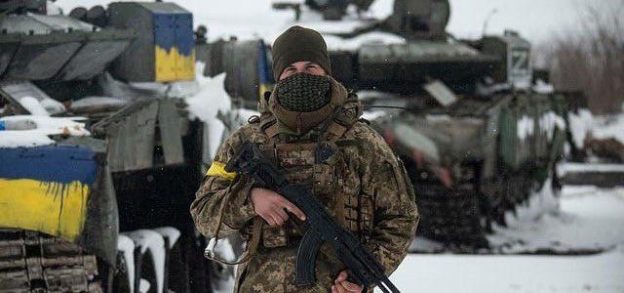A Ukrainian soldier.
Ukrainian defense ministry photo
Russia paused its offensive in Ukraine in recent days in order to rush in reinforcements and rebuild shattered units.
The problem, for the Kremlin, is that Ukraine is doing the same—and potentially to much greater effect. As the wider war in Ukraine enters its fourth week, the Russian army might be able to restore some of the combat power it has lost to poor planning, poorer execution and heroic resistance by the Ukrainian armed services.
But Ukraine almost certainly can double its fighting strength.
That mobilization imbalance, the consequence of strong foreign support for Kyiv, the natural logistical advantages any defender enjoys against an attacker and—most importantly—Ukrainians’ incredible determination to fight, has led one analyst to a perhaps surprising conclusion.
Russia “can’t win this war,” wrote Tom Cooper, an author and expert on the Russian military.
The Russian army built up a force of nearly 200,000 troops with thousands of armored vehicles before launching its assault on southern, eastern and northern Ukraine on the night of Feb. 23.
The invasion force encountered stiff resistance. Not only from the src45,000-person regular Ukrainian army, but also local territorial defense forces and even everyday people who improvised weaponry or found other ways to slow the Russians. Digging ditches. Destroying bridges. Texting Ukrainian artillery units with the locations of approaching Russian tanks.
As the war enters its fourth week, the Russian offensive has stalled. And the scale of Russian losses is becoming clear. The Kremlin on March 2 copped to losing fewer than 500 troops killed in action and another src,500 wounded. The Ukrainian defense ministry a few days ago posited a much higher total: a combined src2,000 Russians “lost”—presumably meaning killed, wounded or captured.
The U.S. Defense Department’s own tally falls between these extremes. The Pentagon on March 8 estimated the Russians had suffered between 2,000 and 4,000 KIAs.
In any event, thousands of fatalities over a period of two or three weeks in a force of 200,000 is unsustainable. There surely are many wounded for every dead. Captives likely number in the hundreds. Survivors of defeated units undoubtedly are traumatized and incapable of fighting.
Worse, the KIAs probably are concentrated in front-line units. Infantry. Armor. Artillery. Those combat arms represent a minority of the invasion force. It’s entirely possible that, in combat units along the front, losses exceed half.
All that is to say, the Russian army is hurt, bad. It should come as no surprise, then, that the ground assault petered out in recent days. The army “seems to be busy hauling whatever reinforcements it can find to the front lines in Ukraine, and replacing mauled units of its first echelon with fresh units of the second,” Cooper wrote.
The problem is that second-line units from Russia’s eastern frontier, inflated by a few thousand Chechens and Syrians, probably can’t fully restore the invasion force.
Now compare that to Ukraine’s own reinforcements. After losing src,300 troops killed in action in the first two weeks, the Ukrainian army mobilized both its first and second echelons of reserve forces, together totaling src50,000 troops. Kyiv is doubling its army.
Don’t doubt that this growing force possesses enough weaponry. Ukraine always kept in storage more vehicles and artillery than it assigned to active brigades. The presence of a few knocked-out Ukrainian T-72 tanks in eastern Ukraine on or around Monday hints at a wide activation of reserve units. Kyiv generally kept its T-72s in reserve while equipping active brigades with older, but superior, T-64s.
The country’s most potent weapons—man-portable anti-tank and air-defense missiles—aren’t in some warehouse. They’re flowing into the country by the thousands, fresh in their shipping crates, from an array of foreign donors including the United States.
As a bonus, many of those missiles require only a few hours of training before an operator is ready to blow up Russian tanks and warplanes.
The Ukrainian and Russian governments are in talks that eventually could produce some sort of ceasefire—or even a more durable peace. In the meantime, it’s obvious that Russia, if not already losing, has stopped winning the war. And the conditions for Russians are getting worse as Kyiv rebuilds its army faster than Moscow can do.
Follow me on Twitter. Check out my website or some of my other work here. Send me a secure tip.

Comments are closed